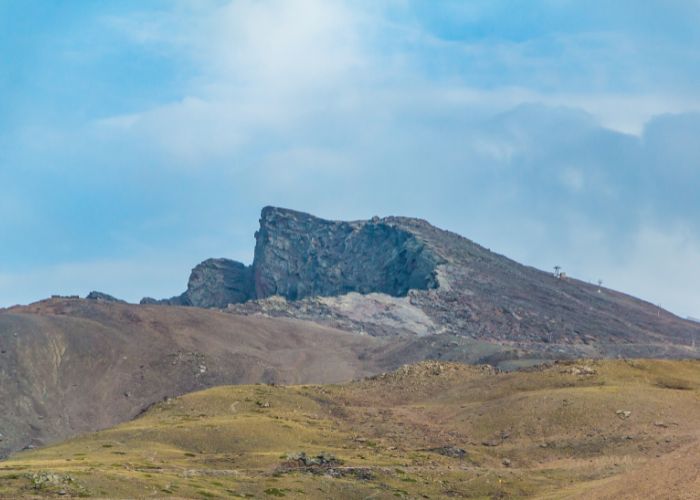GRANADA – It has never happened before that the lagoons in the Sierra Nevada, the high mountains in Andalucia, have completely dried up after the “driest summer” since records are kept.
Researchers from the University of Granada are studying the area’s 74 lagoons. The climate of the past can also be interpreted here. The state of these bodies of water, their sediments and the associated fauna and flora can give a glimpse of what will happen in the future.
Related post: Drought threatens milk and olive oil production in Spain
“They are very good sensors for general change,” said Manuel Villar, a researcher in the Department of Ecology at the University of Granada. Volunteers are involved in several projects, including the 2018 74 High Mountain Glacier Oasis. They take photos and record changes in the lagoons.
Unique year
They conclude that this year was unique. “It is without a doubt the driest year since we have data,” said the researcher. “The thaw happened very quickly.” The high temperatures (with an unusual heat wave in June, still in the spring) and the extraordinary mud rains with desert sands (the calimas) of last March accelerated the process.
The researcher adds that the summer period has been longer than usual and lasted almost six months. He also points out that for the first time since his data, lagoons have completely dried up. At higher temperatures, evaporation has been “greater”, which has affected the lagoons. Especially the highest lagoons ‘Siete Lagunas’, ‘Río Seco’ and ‘Nájera’ have “disappeared”. These lie just below the highest peaks of the Veleta and Mulhacén mountains.
Atypical winter with little snowfall
The six-month summer followed an atypical winter, with little snow until March. From the opening of the Sol y Nieve ski area until March 1, it only snowed for 16 days. This resulted in a total of 41 litres per square metre. This is evident from data provided by Cetursa, the company that manages the ski area. Between March 2 and April 24, 32 days of snow were recorded with a total amount of 245 litres per square metre. This allowed aquifers or reservoirs such as canals and lagoons to fill with meltwater.
Microplastic
Within the 74 Oasis Glaciares initiative – a pioneering initiative in Spain – samples are taken in these lagoons. This exposed another environmental problem; the presence of microplastics. Not only is there little water, but the condition of the water is also not good. Antonio Castillo, a researcher at the Water Institute at the University of Granada, also warns that water decay is not just due to drought.
Also read: Spain could turn into a desert landscape this century
Like other natural areas in Andalucia such as Doñana, the waters in the province of Granada and thus the Sierra Nevada – both above ground and underground – suffer from the risk of overexploitation. In the case of Doñana, this has already led to the drying up of lagoons vital to the millions of migratory birds that pass through them every year. In Granada, according to Castillo, the “exhaustion” has already been registered in the spring.
Chemicals and Overexploitation
The environmental organisation Greenpeace also points to the poor condition of several aquifers in the province, both due to chemicals and over-exploitation. According to Castillo, the underground reservoirs are “much larger” than surface reservoirs. These are filled with water via the same mechanism as the above-ground reservoirs. That comes out through the spillways (sources). But they are now in danger of drying up.
Insufficient water to meet the demand
The Ministry for the Ecological Transition and the Demographic Challenge stated that “the decrease in rainfall over the past year, in addition to a drastic drop in the level of the Cubillas and Colomera reservoirs (both north of the city of Granada), has led to a significant reduction in the flow “in this spring. That means the water it can supply is “insufficient to meet demand,” the ministry said.
Poorly filled aquifers
The aquifers aren’t well filled either, says Castillo, who promotes the “Know Your Sources” project, among other things. He points out that there are very few wells with a water flow of more than 100 litres per second. His initiative catalogued 2,342 points where water flows in the province of Granada. In only 23 of these, the flow is still powerful, i.e. higher than 100 litres per second.
Castillo warns that this unexciting data is not up-to-date and thus “underestimated”. With updated data, the picture would be more pessimistic. According to the researcher, it is clear that the water supply is problematic because its consumption exceeds what is replenished by rain.
Rural areas are increasingly deserted
Agriculture sees the expert as another key to the troubling situation: “People are leaving the rural world” is another cause of resource wilting. “Every farm used to have a fountain, a trough…that system of locks has been lost.”


